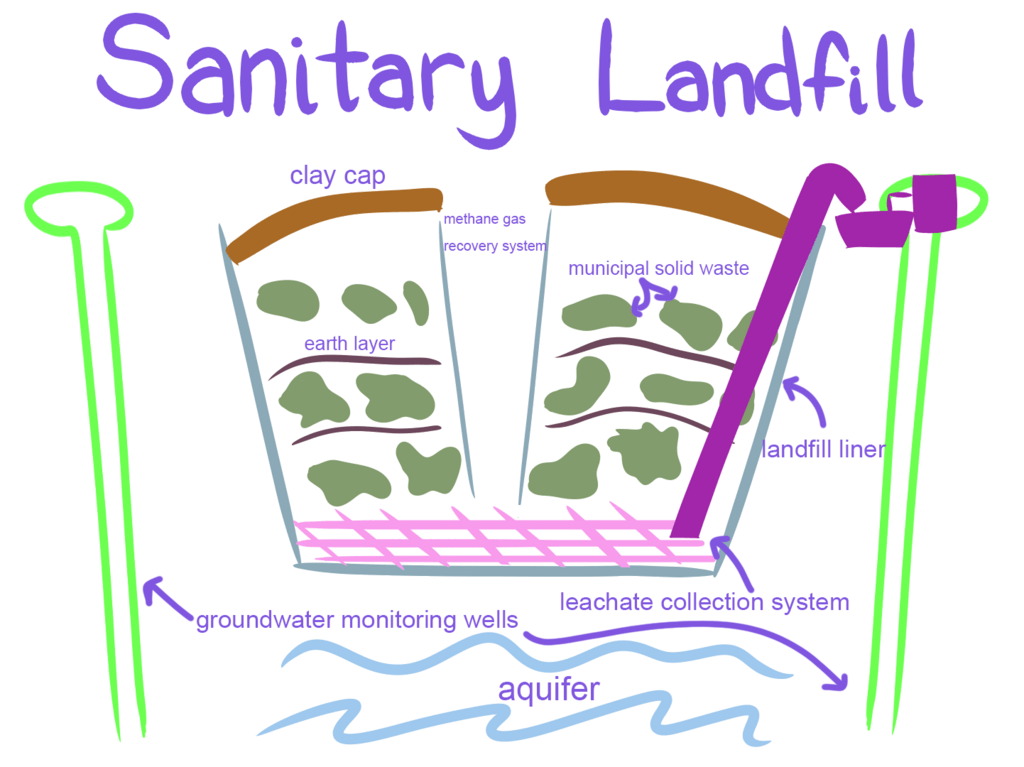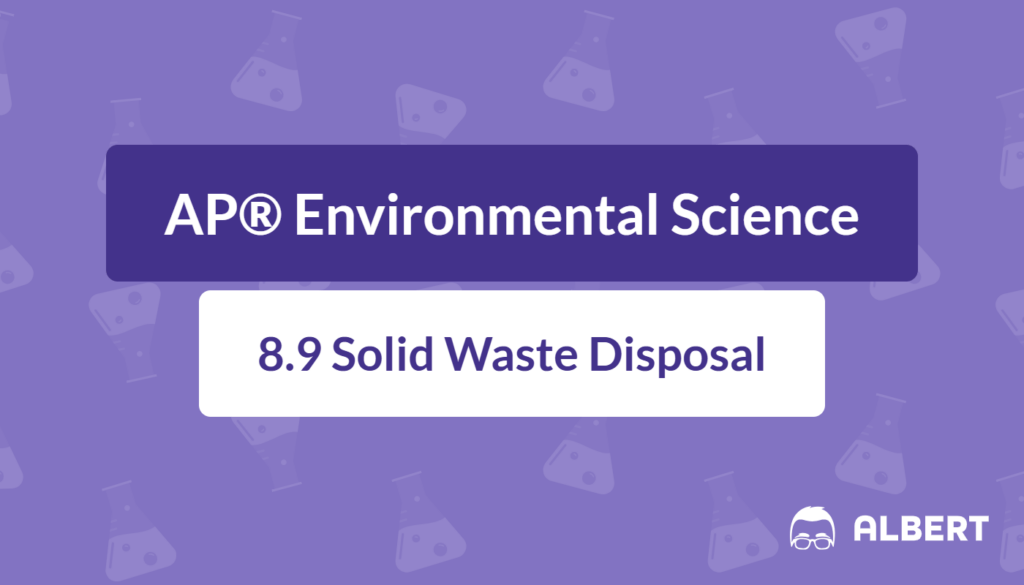What We Review
Introduction
Solid waste disposal is a critical topic in AP® Environmental Science because it affects both the environment and human health. Properly disposing of waste reduces pollution and protects ecosystems. However, inadequate disposal methods can contaminate soil and groundwater, release harmful gases such as methane, and contribute to the formation of large floating trash patches in the ocean. Therefore, studying how solid waste is handled provides insights into broader environmental concepts, including the carbon cycle, population growth models, and even potential renewable energy sources.
In modern societies, rising populations generate increasing amounts of solid waste. Many communities rely on landfills for final disposal. Others use incineration facilities, while some areas still face challenges with illegal dumping. Consequently, understanding the science behind each method enables students to recommend more sustainable approaches.
What Is Solid Waste?
Solid waste refers to any discarded material that is neither a liquid nor a gas. In daily life, this can include food scraps, packaging, paper, yard trimmings, and e-waste. Additionally, many industrial, business, and agricultural activities generate large volumes of waste materials. As population growth models predict continued increases in waste production, the need for efficient waste management is more urgent than ever.
Types of solid waste can be broadly categorized as follows:
- Domestic waste: Household trash like food scraps, plastics, and paper.
- Industrial waste: Manufacturing and production byproducts such as scraps of metal or chemicals.
- Business waste: Office paper, cardboard, and obsolete electronics.
- Agricultural waste: Crop residues and livestock manure.
When managed improperly, these materials can degrade ecosystems and threaten human health. Therefore, waste management strategies aim to minimize harm and, if possible, harness the potential benefits of waste for energy recovery or recycling.
Common Methods of Solid Waste Disposal
Landfills
A landfill is a site specifically designed for the burial of waste. Most residential and commercial trash ends up in sanitary municipal landfills, which are engineered to minimize negative environmental impacts. However, landfills can still lead to issues such as groundwater contamination, greenhouse gas emissions (especially methane), and limited space.
Key components of a sanitary municipal landfill often include:
- Bottom liner (plastic or clay) to prevent leachate from infiltrating groundwater.
- Stormwater collection system to redirect rainwater away from waste piles.
- Leachate collection system to capture water that percolates through the waste.
- Cap (or cover) to seal off the landfill once it reaches capacity.
- Methane collection system to capture and control methane release, occasionally using it to produce a form of renewable energy.
Example: Steps in a Sanitary Municipal Landfill
- Waste is brought to a designated cell and spread in compacted layers.
- Each day, a thin soil cover is added to reduce odors and pest invasions.
- Stormwater systems direct rain away from the waste, reducing leachate formation.
- Leachate collection pipes channel contaminated liquid to a treatment facility.
- A cap is installed on a completed section to seal the waste and prevent exposure.
- Methane naturally forms as microbes decompose organic matter, and a methane collection system reduces greenhouse gas emissions.

Incineration
Incineration involves burning waste at high temperatures, significantly reducing its volume. It can decrease the total mass of waste sent to landfills by approximately 70–90 %. However, incinerators can emit air pollutants if not equipped with proper filtration systems. Therefore, although incineration addresses volume constraints, controlling emissions is essential to minimize harmful effects on air quality.
Example: Waste Incineration Process
- Waste is screened to remove items, such as materials that might release excessive toxins.
- It is then moved into a furnace where temperatures can exceed 1,000 °C.
- As the waste burns, heat energy may be captured to produce steam or electricity.
- Flue gases pass through filters or scrubbers to reduce air pollutants.
- The remaining ash (bottom ash) is removed and may later be used in construction or disposed of in landfills.
Illegal Dumping
Illegal dumping occurs when individuals or businesses dispose of waste in unauthorized locations, such as empty lots or roadsides. Unfortunately, improper waste disposal can create health hazards. For instance, used rubber tires left in piles can become breeding grounds for mosquitoes. These insects can spread diseases such as dengue or malaria to local populations.
Example: Rubber Tire Pile and Mosquito Issues
- Individuals discard old tires without using an approved disposal method.
- Rainwater collects in the tire rims, forming small pools of standing water.
- Mosquitoes lay eggs in these pools, promoting rapid population growth.
- Nearby communities experience escalated mosquito-borne diseases.
- Public health officials must then address both cleanup and disease control.
Ocean Dumping
Some countries still practice ocean dumping, whereby waste is discarded directly into maritime environments. Consequently, large areas of debris, such as the Great Pacific Garbage Patch, have emerged. Ocean dumping poses severe threats to marine animals that consume or become entangled in plastic. Additionally, plastic waste can break down into microplastics, harming ecosystems far beyond the initial dumping sites.
Example: Impacts on Marine Life
- Plastic bags and bottles are thrown overboard or carried to seas by rivers.
- Currents concentrate these materials into large “garbage patches.”
- Marine animals mistake microplastics for food, which can damage digestive systems.
- Entanglement also prevents normal movement and feeding, possibly leading to injury or death.
- This waste may remain in the oceans for hundreds of years, affecting countless species.
Effects of Solid Waste Disposal Methods
Each disposal method has tremendous ecological and health implications. Landfills, for example, trap a variety of materials. Certain items break down organically, releasing methane (a greenhouse gas). Moreover, if the landfill’s bottom liner fails, pollutants may seep into groundwater. Incineration can limit the amount of solid waste but, without proper air pollution control, it can release harmful substances into the atmosphere. Illegal dumping leads to localized environmental damage and public health concerns. Meanwhile, ocean dumping disrupts marine ecosystems, affecting biodiversity and food webs.
When considering landfill decomposition, the trash composition matters. Organic waste decomposes more readily, producing methane and carbon dioxide. However, plastics, metals, and glass can remain intact for decades or centuries. Microbial activity in landfills often requires proper moisture levels and temperatures, although too much water can increase leachate production. Therefore, designing landfills is an exercise in balancing waste composition, microbial decomposition conditions, and environmental safety measures.
Innovative Solutions and Alternatives
To minimize reliance on landfills and reduce the adverse effects of incineration, communities are turning to alternatives. Recycling and composting help divert a substantial portion of the waste stream. Likewise, e-waste processing programs can reclaim valuable materials, such as metals in computer circuit boards, and reduce harmful substances that might otherwise end up in landfills.
Recycling:
- Waste materials like paper, glass, metals, and certain plastics are separated.
- These materials are cleaned and shipped to processing facilities.
- They are then transformed into raw materials that can be used to make new products.
Composting:
- Organic waste like food scraps and yard trimmings is collected.
- Microbial decomposition is accelerated through proper aeration, moisture, and temperature control.
- The end product is nutrient-rich compost that can be added to soil to enhance plant growth.
These strategies also shrink the total waste headed to landfills. Meanwhile, landfill methane can be harnessed as a possible renewable energy source. In some sanitary municipal landfills, methane collection systems transport the gas to a facility that burns it for electricity generation. Therefore, proper waste handling can intersect with broader sustainability goals, tying back to concepts in the carbon cycle and population growth models.
Conclusion
Proper solid waste disposal is a foundational topic in AP® Environmental Science. Landfills, incineration, illegal dumping, and ocean dumping can each negatively impact ecosystems, public health, and the global environment. However, students and communities can take action by promoting recycling, composting, and careful disposal of e-waste. Another important step is supporting policies that ensure landfills capture methane, manage leachate, and reduce air pollutants.
Some steps that can improve waste management:
- Encouraging citizens to separate recyclables at home.
- Organizing local composting programs.
- Advocating for stricter e-waste disposal regulations.
- Supporting legislation that cracks down on illegal dumping.
Applauding existing initiatives fosters a culture of environmental stewardship. Ultimately, reducing, reusing, and recycling lead to a healthier environment for everyone.
Key Vocabulary
- Solid Waste: Discarded material that is not a liquid or gas.
- Landfill: A site for the disposal of waste materials by burial.
- Sanitary Municipal Landfill: A designated landfill for non-hazardous waste, designed to minimize environmental impact.
- E-waste: Discarded electronic devices like televisions, cell phones, and computers.
- Incineration: The burning of waste at high temperatures to reduce its volume.
- Leachate: Liquid that drains or “leaches” from a landfill, which can contaminate groundwater.
Sharpen Your Skills for AP® Environmental Science
Are you preparing for the AP® Environmental Science test? We’ve got you covered! Try our review articles designed to help you confidently tackle real-world AP® Environmental Science problems. You’ll find everything you need to succeed, from quick tips to detailed strategies. Start exploring now!
- AP® Environmental Science: 8.6 Review
- AP® Environmental Science: 8.7 Review
- AP® Environmental Science: 8.8 Review
Need help preparing for your AP® Environmental Science exam?
Albert has hundreds of AP® Environmental Science practice questions, free response, and full-length practice tests to try out.








